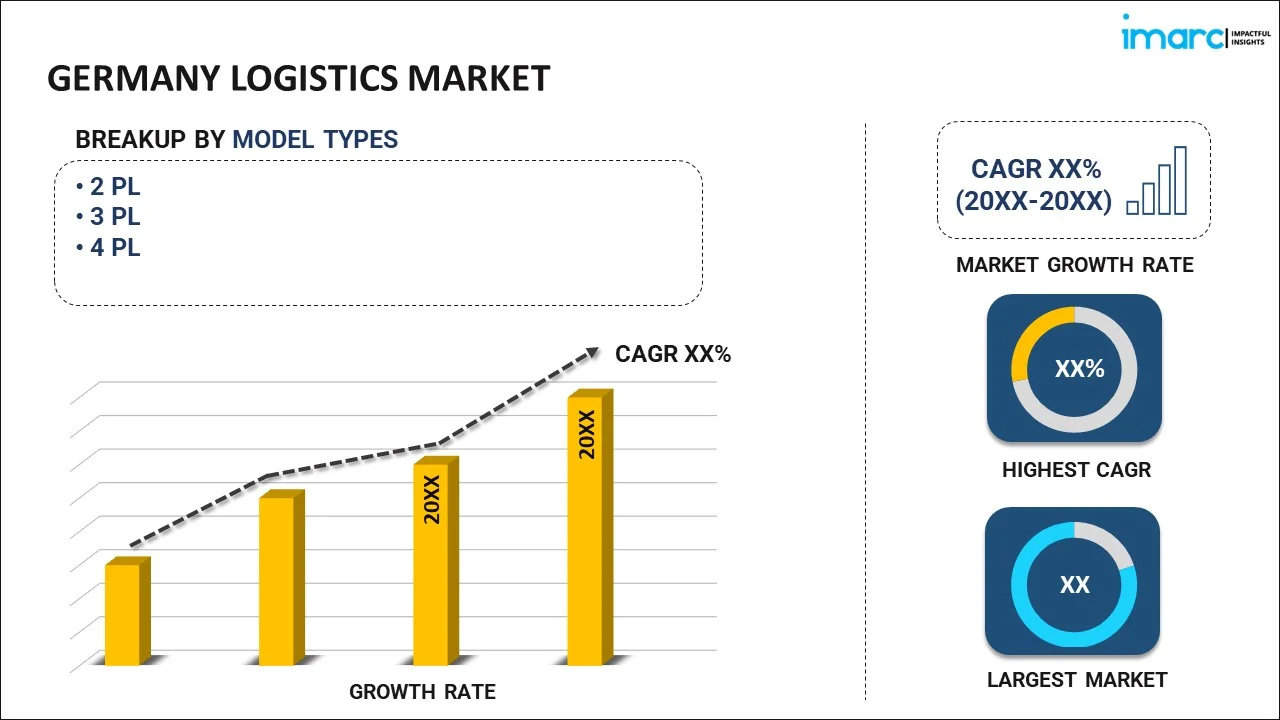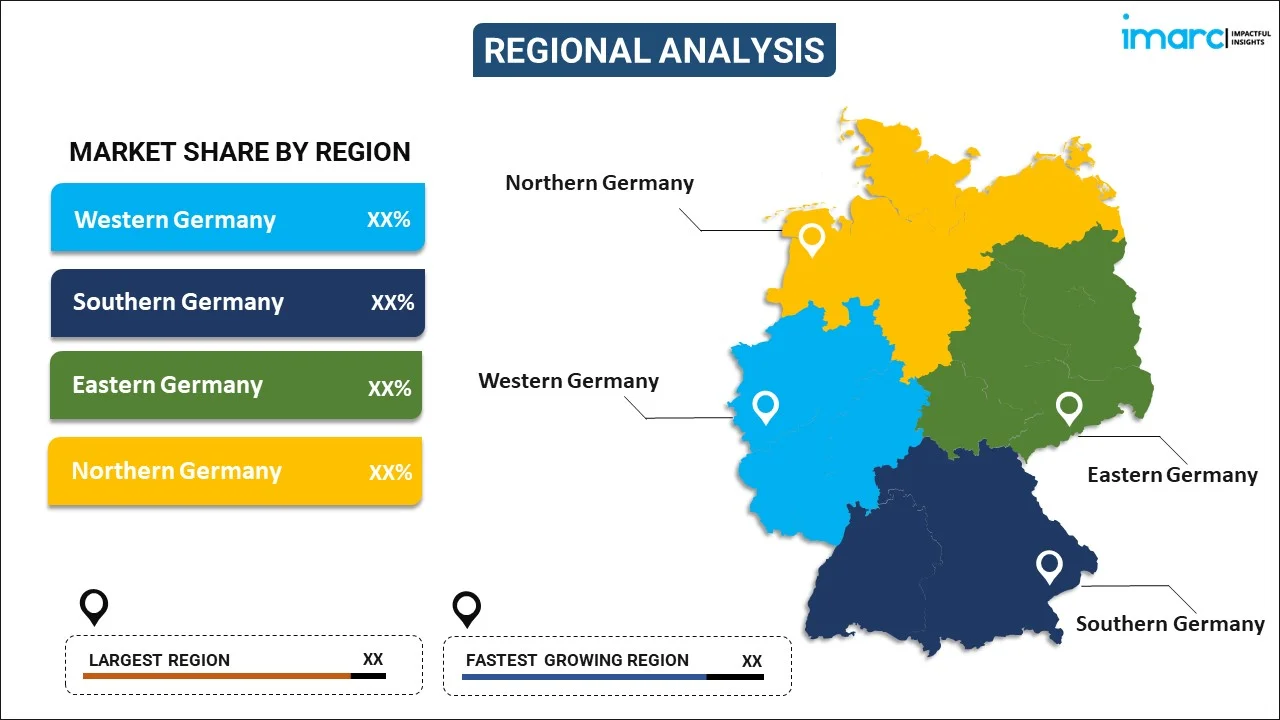
Germany Logistics Market Report by Model Type (2 PL, 3 PL, 4 PL), Transportation Mode (Roadways, Seaways, Railways, Airways), End Use (Manufacturing, Consumer Goods, Retail, Food and Beverages, IT Hardware, Healthcare, Chemicals, Construction, Automotive, Telecom, Oil and Gas, and Others), and Region 2025-2033
Germany Logistics Market Overview:
The Germany logistics market size reached USD 217.2 Billion in 2024. Looking forward, IMARC Group expects the market to reach USD 451.0 Billion by 2033, exhibiting a growth rate (CAGR) of 7.80% during 2025-2033. The market is driven by e-commerce growth, which consequently results in larger number of parcels and require enhanced logistics operations to complete deliveries on time, along with the highly developed transportation infrastructure that is important for improved logistics services.
|
Report Attribute
|
Key Statistics
|
|---|---|
|
Base Year
|
2024
|
|
Forecast Years
|
2025-2033
|
|
Historical Years
|
2019-2024
|
|
Market Size in 2024
|
USD 217.2 Billion |
|
Market Forecast in 2033
|
USD 451.0 Billion |
| Market Growth Rate 2025-2033 | 7.80% |
Germany Logistics Market Trends:
E-Commerce Growth
According to the International Trade Administration’s report 2023, the total sales via e-commerce in Germany was estimated to be USD 141.2 billion in 2022, which is 11% higher as compared to 2021. E-commerce causes a significant increase in parcel volumes as customers order more things online. This growth in parcel numbers needs larger logistics operations to meet the increased demand for deliveries. The advent of e-commerce is increasing the need for efficient last-mile delivery options. People expect speedy and dependable delivery services, which encourages logistics companies to develop and optimize their last-mile delivery procedures. To address the demands of e-commerce, businesses are investing in larger and larger warehouse and fulfillment facilities. These facilities are strategically placed to provide prompt and efficient distribution to customers.
E-commerce expansion is driving the deployment of modern logistics systems. This incorporates warehouse automation, real-time tracking systems, and sophisticated inventory management software to assure timely and correct deliveries. Logistics operations must be more flexible in order to meet the needs of e-commerce. To meet customer expectations, businesses must provide a variety of delivery alternatives, such as same-day delivery, click-and-collect, and delivery time windows. In the competitive e-commerce sector, the buyer experience is critical. Efficient and dependable logistics services are critical for delivering a pleasant customer experience, influencing repeat purchases, and building customer loyalty.
Highly Developed Transport Infrastructure
As per the WorldData’s report 2024, the rail network in Germany is 39,379 kilometers long and freight traffic on the rails is 123.07 billion tons. It also shows that there are 16 international airports in the country, 12 of which are considered major airports. Besides this, the length of paved and asphalted roads and highways alone amounts to a total of 830,000 km. Along with this, this report claims that in 2021 about 14.72 million freight containers were transported through waterways in Germany. Germany has a vast and well-maintained network of highways and auxiliary roads, allowing for fast and dependable road transportation. This efficiency is crucial for domestic and international trucking routes. The country's extensive rail network enables the movement of commodities over great distances with high efficiency and a lesser environmental impact than vehicle travel. Rail freight is critical for heavy industries and big commodities.
Germany's ports, including the Ports of Hamburg and Bremen, are among the busiest in Europe, permitting large volumes of international trade. The enormous network of rivers and canals, including the Rhine and Danube, enables effective inland water transport while also integrating internal and international operations. Major international airports, such as Frankfurt and Munich, function as key air freight hubs. These airports provide substantial cargo handling capabilities and global connectivity, which is critical for high-value and time-sensitive goods.
Germany Logistics Market News:
- March 2024: FedEx Express opened a new logistics facility in Kabelsketal, close to Leipzig/Halle Airport, to enhance its logistics capabilities in Germany.
- January 2024: DACHSER, a renowned logistics provider, launched a new product by the name ‘Targo on-site fix” that provide flexibility to people while arranging their delivery dates.
Germany Logistics Market Segmentation:
IMARC Group provides an analysis of the key trends in each segment of the market, along with forecasts at the country level for 2025-2033. Our report has categorized the market based on model type, transportation mode, and end use.
Model Type Insights:

- 2 PL
- 3 PL
- 4 PL
The report has provided a detailed breakup and analysis of the market based on the model type. This includes 2 PL, 3 PL, and 4 PL.
Transportation Mode Insights:
- Roadways
- Seaways
- Railways
- Airways
A detailed breakup and analysis of the market based on the transportation mode have also been provided in the report. This includes roadways, seaways, railways, and airways.
End Use Insights:
- Manufacturing
- Consumer Goods
- Retail
- Food and Beverages
- IT Hardware
- Healthcare
- Chemicals
- Construction
- Automotive
- Telecom
- Oil and Gas
- Others
The report has provided a detailed breakup and analysis of the market based on the end use. This includes manufacturing, consumer goods, retail, food and beverages, IT hardware, healthcare, chemicals, construction, automotive, telecom, oil and gas, and others.
Regional Insights:

- Western Germany
- Southern Germany
- Eastern Germany
- Northern Germany
The report has also provided a comprehensive analysis of all the major regional markets, which include Western Germany, Southern Germany, Eastern Germany, and Northern Germany.
Competitive Landscape:
The market research report has also provided a comprehensive analysis of the competitive landscape. Competitive analysis such as market structure, key player positioning, top winning strategies, competitive dashboard, and company evaluation quadrant has been covered in the report. Also, detailed profiles of all major companies have been provided.
Germany Logistics Market Report Coverage:
| Report Features | Details |
|---|---|
| Base Year of the Analysis | 2024 |
| Historical Period | 2019-2024 |
| Forecast Period | 2025-2033 |
| Units | Billion USD |
| Scope of the Report | Exploration of Historical and Forecast Trends, Industry Catalysts and Challenges, Segment-Wise Historical and Predictive Market Assessment:
|
| Model Types Covered | 2 PL, 3 PL, 4 PL |
| Transportation Modes Covered | Roadways, Seaways, Railways, Airways |
| End Uses Covered | Manufacturing, Consumer Goods, Retail, Food and Beverages, IT Hardware, Healthcare, Chemicals, Construction, Automotive, Telecom, Oil and Gas, Others |
| Regions Covered | Western Germany, Southern Germany, Eastern Germany, Northern Germany |
| Customization Scope | 10% Free Customization |
| Post-Sale Analyst Support | 10-12 Weeks |
| Delivery Format | PDF and Excel through Email (We can also provide the editable version of the report in PPT/Word format on special request) |
Key Questions Answered in This Report:
- How has the Germany logistics market performed so far and how will it perform in the coming years?
- What has been the impact of COVID-19 on the Germany logistics market?
- What is the breakup of the Germany logistics market on the basis of model type?
- What is the breakup of the Germany logistics market on the basis of transportation mode?
- What is the breakup of the Germany logistics market on the basis of end use?
- What are the various stages in the value chain of the Germany logistics market?
- What are the key driving factors and challenges in the Germany logistics?
- What is the structure of the Germany logistics market and who are the key players?
- What is the degree of competition in the Germany logistics market?
Key Benefits for Stakeholders:
- IMARC’s industry report offers a comprehensive quantitative analysis of various market segments, historical and current market trends, market forecasts, and dynamics of the Germany logistics market from 2019-2033.
- The research report provides the latest information on the market drivers, challenges, and opportunities in the Germany logistics market.
- Porter's five forces analysis assist stakeholders in assessing the impact of new entrants, competitive rivalry, supplier power, buyer power, and the threat of substitution. It helps stakeholders to analyze the level of competition within the Germany logistics industry and its attractiveness.
- Competitive landscape allows stakeholders to understand their competitive environment and provides an insight into the current positions of key players in the market.
Need more help?
- Speak to our experienced analysts for insights on the current market scenarios.
- Include additional segments and countries to customize the report as per your requirement.
- Gain an unparalleled competitive advantage in your domain by understanding how to utilize the report and positively impacting your operations and revenue.
- For further assistance, please connect with our analysts.
 Request Customization
Request Customization
 Speak to an Analyst
Speak to an Analyst
 Request Brochure
Request Brochure
 Inquire Before Buying
Inquire Before Buying




.webp)




.webp)












